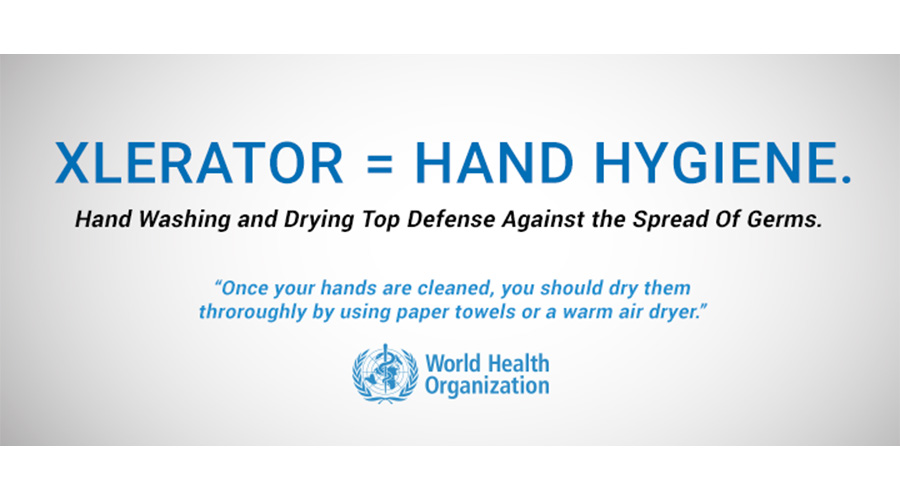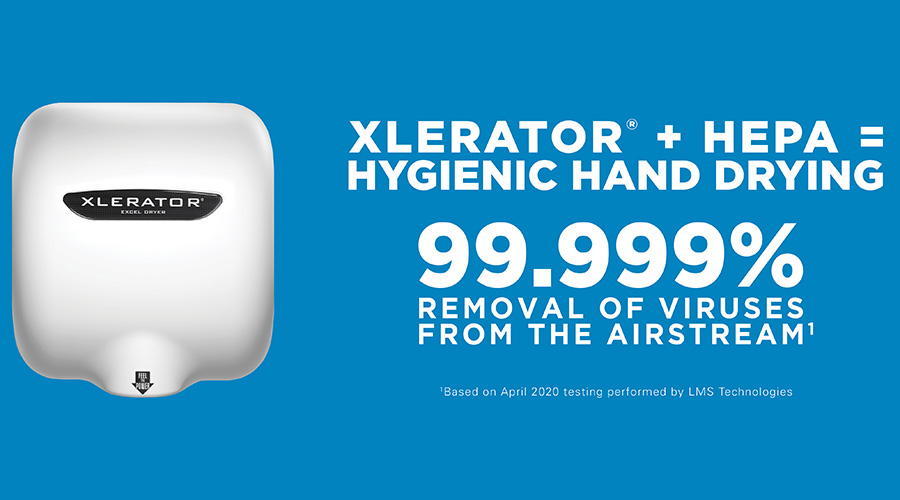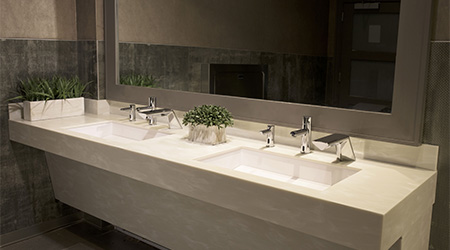SPONSORED
Excel Dryer - Branded Feature
Clearing the Air: Hand Dryers are Hygienic
As the emergence of COVID-19 has gradually but surely changed the very ways we live, infection control has become global society's top priority. In turn, hand hygiene, including hand washing and drying and restroom cleanliness, have become more relevant than ever — and hand dryers are a good, clean part of it.
Experts from the World Health Organization (WHO) state that proper hand hygiene is the best defense against the spread of germs, like coronavirus. Specifically, the WHO recommends that everyone "frequently clean [their] hands…" and "dry [them] thoroughly by using paper towels or a warm air dryer." Moreover, they, along from experts from the Centers for Disease Control and Prevention and Johns Hopkins University have stated that "there is no evidence that hand dryers are spreading the [corona]virus."
With that said, when it comes to germs, hand washing is only half of the hand hygiene equation. Hand drying is equally, if not more important, and choosing a touchless hand dryer as a solution not only follows health organization guidance — it creates a tidy restroom environment, giving visitors peace of mind.
Still, some misinformation and confusion about the hygienic efficacy of hand dryers exists. This could be due in part to sensationalized news accounts, conflicting advice on the internet, or an underlying fear of contracting the coronavirus.
Through this narrative from leading hand dryer manufacturer, Excel Dryer — whose hand dryers are used by commercial facilities around the world including shopping malls, airports, restaurants, schools and universities, stadiums and arenas, hospitals and healthcare facilities, public safety complexes to achieve proper hand hygiene — key hygiene topics will be covered including hand drying product and maintenance considerations, and findings and advice from health experts to educate and alleviate any misgivings that might be held about hand dryers as the hygienic hand drying solution they are.

First Things First: Method Matters
Best to first discuss the first half of the process to achieve hand hygiene: hand washing. The practice of proper handwashing is so important that the Centers for Disease Control and Prevention (CDC) have dubbed it a "do-it-yourself vaccine." Though thorough washing your hands may seem like a simple, intuitive task, an estimated 95 percent of Americans (per a 2013 "undercover" study by Michigan University researchers) are not doing a sufficient job — leaving countless germs behind.
To ensure that you are washing your hands properly, the World Health Organization (WHO) recommends following this step-by-step method:
- Wet your hands with water and turn off the tap. (Editor's note: ideally, auto sensors control the tap and/or soap dispenser.)
- Apply enough soap to cover all hand surfaces.
- Lather your hands completely. Don't neglect backs of hands, wrists and under nails.
- Scrub for at least 20 seconds. Duration is key and where many fall short. A good measure is to hum all of "Happy Birthday" twice.
- Rinse hands with water.
- Once your hands are cleaned, dry them thoroughly using a paper towel or warm air dryer.
Though infection control standards mandate proper hand hygiene practices in certain industries, such as health care and food services, washing hands properly and often is critical for everyone — certainly in times like the current one, but truly, at all times. When it comes to protecting the health of our communities, our families and ourselves, "all hands on deck" makes all the difference, as does ensuring that hands are completely dry.
Hand Drying With Hand Dryer vs Paper Towels: A Comparison
While both are recognized as safe, effective and hygienic ways to dry hands, paper towels come with their own challenges:
- Limited supply. As we saw during the pandemic, paper products can run out, and paper towels are no exception. If unavailable, hands cannot be dried at all — and wet hands have been shown to be 1,000 times more likely to transfer germs than dry hands.
- Hygiene. Paper towels can be left in damp piles on countertops, across the floor, spilling out of trash cans and clogging up toilets. These messes provide breeding grounds for dangerous bacteria at a time when hygiene is a matter of life and death. One independent study showed 17 species of bacteria on unused, recycled paper towels, including Bacillus, which can cause food poisoning.
- Source: Paper towels come from trees, a threat against the increasingly important need for environmentally sustainable practices.
- Transportation: Gas-consuming, carbon-emitting delivery trucks are required to transport lumber to mills and finished product to businesses; paper waste must also be transported from facilities, to landfills.
- Production: Paper is produced through chemical or mechanical pulping — another stress on the environment — One ton of paper uses 20,000 gallons of water in production.
- Maintenance: Paper towels require labor hours to stock, restock, clean and discard.
- Life Cycle: A used paper towel — even if 100% recycled — has only one ultimate destination: the landfill.
Hand dryers offer the following benefits over paper towels:
- Hygiene. Hand dryers eliminate the mess of paper towels. Hands-free, no-touch sensors reduce the number of restroom touchpoints, a crucial asset in the fight for public health.
- Sustainability: Compared to paper towels and traditional hand dryers, XLERATOR® provides up to a 75 percent reduction in carbon footprint.
- Cost. XLERATOR® provides a 95 percent cost savings versus paper towels.
- Labor. XLERATOR® eliminates the labor, maintenance and waste of paper towels.
The aforementioned aren't just marketing jargon or unsubstantiated statements; to the contrary, each is corroborated and detailed below.
Facts, Not Fear
Despite recommendations from credible health organizations about the importance of hand drying, coupled with scientific results that hand dryers can achieve completely dry hands, misinformation about hand dryers remains online, and continues to be quoted and perpetuated. Kelly Reynolds, Ph.D., Professor and Chair of the Department of Community, Environment and Policy; Director of the Environment, Exposure Science and Risk Assessment Center (ESRAC) at the University of Arizona's Zuckerman College of Public Health; and corresponding researcher of Comparison of Electric Hand Dryers and Paper Towels for Hand Hygiene: A Critical Review of the Literature, offered an explanation as to the root of these misconceptions, stating that, "Consumers may only read [sensationalized] headlines which can influence public opinion toward biased or erroneous conclusions, [but] the fact is, the breadth of data available does not favor one hand drying method as being more hygienic or safer."
When architects or designers are choosing a hand drying solution to implement, it can prove difficult to know which group or study to refer to. Two studies often cited for their scientific rigor include findings from the Mayo Clinic and researchers at the University of Auckland.
The Mayo Clinic previously studied and reported on the different types of hand drying finding that "…there is no difference in bacteria counts when drying with paper towels or hand dryers." Another independent study from the University of Auckland found that wet hands have been shown to be 1,000 times more likely to transfer germs than dry hands.
Studies like this help to articulate what we long have known: germ removal itself happens through proper handwashing, regardless of drying method; and hands-under, high-speed, energy-efficient hand drying achieved by Excel Dryer's products is an efficient and sanitary method for drying hands after washing.
Correcting the Myths
Myth 1: "Paper towels are a 'greener' option than hand dryers."
Sustainability is a major area of unfounded concerns regarding hand dryers. Fact: A Life Cycle Assessment (LCA) Study conducted by Quantis, an international life cycle assessment research firm, and peer reviewed to ISO 14040 Standards, disproved the notion that paper towels are better than the environment than Excel Dryer's original, patented, high-speed, energy-efficient XLERATOR® Hand Dryer. The study, conducted in 2009, determined that when compared to traditional electric hand dryers and paper towels (virgin and 100% recycled content), the high-efficiency dryer reduces the Climate Changing Score (carbon footprint) of hand drying by 50%–75%. The XLERATOReco® Hand Dryer from Excel Dryer uses no heat technology to dry hands fast using only 500 watts, making it the most environmentally friendly hand dryer on the planet.
Considering the processes required in their ongoing manufacture and disposal — keeping in mind that "recycled" is NOT the same as "recyclable" — paper towels are not necessarily the highly sustainable option many believe them to be.
Myth 2: "Paper towels are more cost effective."
This is yet another misconception that feeds the great hand-drying debate. The fact is this: Converting from paper towels to our energy-efficient hand drying units actually represents a 95% cost savings, and the typical payback period for retrofitting from paper to the XLERATOR® is less than a year.
These proven statistics easily stand to reason. The dryer is a one-time purchase; once installed, it requires significantly less attention than paper towel dispensers, saving you money on labor and maintenance. Further, in contrast to paper towels, which can cost $15–$30 or more per case, the energy costs of using a hand dryer (as referenced above) amount to pennies per day.
As a facilities manager, business owner or organizational leader, you have choices to make when it comes to products and systems that best support your mission. Where sustainability, cost and health concerns matter, choose to throw in the towel — and know you've chosen wisely.
Myth 3: "Hand Dryers Aren't Hygienic"
The great debate of hand dryers vs. paper towels has gone on for years through studies largely funded by the paper towel industry and most recently by way of news articles and viral social media posts. The problem with these stories is that they are often one-sided and written in a manner to either sensationalize — illicit fear — or both. In short: they do not tell the whole story or share the whole truth. Some news outlets have erroneously reported on matters surrounding the efficacy of hand dryers.
Despite these claims, the fact remains the same: no touch, sensor-activated, hands-under, high-speed, energy-efficient hand drying is the most efficient and sanitary method for drying hands after washing. In these unprecedented times, it is imperative that truths be shared to prevent the spread of germs and illnesses. And, as health experts have confirmed, hand dryers alone can't kill COVID-19, and moreover, they do not spread the virus.
There's no denying paper towel waste is the cause of many, if not most, conditions that make a restroom visibly unclean. Simply put, hand dryers eliminate this waste — altogether. The fact is, used paper towels are often found everywhere but the trash bin. They're thrown on the floor (especially if the bin is already overflowing) or worse, into the toilet. Installing hand dryers eliminates the threat of the plumbing issues that could arise with paper towel misuse.
With the above myths busted, the conversation will turn to considerations for hand dryer selection.
Dry (By Definition)
Prior to 2016, there was no standardized way to measure the complete dryness of ones hands after the use of a hand dryer. That all changed, however, during the creation of Product Category Rules (PCR) for the hand dryer industry. PCRs help minimize market confusion by streamlining the procedures by which products are evaluated for environmental impacts and ensure a globally consistent data collection and analysis.
To calculate the environmental impact of dryers, their life cycle needed to be calculated, and in order to properly calculate life, each dry cycle needed to be calculated; this required "dry" to be given a numerical value, to determine how many cycles a dryer could perform during its usable operation period.
In the end, "dry" came to be defined as residual moisture equaling 0.25 grams or less. When tested to the globally established PCR standards, the XLERATOR® line of hand dryers from Excel Dryer were proven to completely dry hands in 8 seconds.
When deciding which hand dryer to purchase or use, an important product consideration is whether or not the unit was tested to PCR standards. If it in fact was, you have the peace of mind and assurance that it meets strict testing standards. To know for sure, look for markings that say "UL" on the unit or in the unit's marketing materials. These letters stand for Underwriters' Laboratories and their mark appears on electronic items across the spectrum of industries. Interestingly, UL Environment, a business division of Underwriters' Laboratories, was involved in the hand dryer industry's PCR creation.
Reducing Restroom Touchpoints for Better Hand Hygiene
As facility professionals are all too aware, restroom patrons and maintenance professionals alike often encounter a wide range of surfaces that require their touch — door handles, stall latches, toilet seats, sink faucet handles and more. Reducing the number of required restroom touchpoints can cut the number of times hands are exposed to germs. Likewise, a reduction of touchpoints will also cut down on time required to complete restroom deep cleaning, a reality of our collective "new normal." Good product design can achieve a touchpoint reduction and contribute to a restroom's good hygiene.
Excel Dryer has been a leader in the hand dryer industry since 2001 with the advent of the revolutionary XLERATOR® Hand Dryer, a product so revolutionary that it necessitated the creation of a new product category: high-speed, energy-efficient. Since, Excel has added the XLERATOReco®, XLERATORsync® and ThinAir® Hand Dryers to its product line, but the hands-under product design has remained the same to ensure hygienic, touchless operation.
The hands-under style of dryers is sensor activated, that is, the motor is turned on and the drying of hands begins once a user's hands are placed below the hand dryer unit. This is an effective hand drying option and helps to promote hand hygiene and create a more hygienic restroom experience. Air and water from hands are blown downward and away from user, as opposed to being captured in the unit, a problem encountered by trough-style dryers, also commonly referred to as "hands-in" units.
Some customers opt to install antimicrobial wall guards below their units for an added level of protection, particularly in high-traffic areas or on walls that are not easily disinfected, like dry wall, as opposed to tile, which can be sprayed with disinfectant and wiped down. The antimicrobial wall guards are stainless steel or are manufactured with Microban® antimicrobial additive are designed specifically to fit securely underneath any Excel Hand Dryer, protecting walls and helping create a more hygienic restroom environment.

Next Level Hygiene: HEPA Protection
All dryers in Excel's line are hygienic, but dryers with HEPA have been proven to add another level of protection. Viral efficiency testing conducted by the preeminent independent air media and filter testing company, LMS Technologies in April of 2020 found that XLERATOR®, XLERATOReco® and XLERATORsync® Hand Dryers with HEPA Filtration Systems remove 99.999 percent of viruses from the airstream. The 380 million viruses used during the testing ranged in size between 16.5 and 604.3 nanometers — not dissimilar to the size of the novel coronavirus.
Of the results, LMS Technologies President Al Vatine said, "The virus used in the test represents all viruses, like coronavirus in terms of their size or how they would react to the filter. I can, with confidence, tout the effectiveness of the XLERATORs with HEPA filtration systems. If it can perform this effectively in an enhanced, virus-infused scenario, it surely would provide effective filtration in real-world settings."
The HEPA Filtration System comes standard in the XLERATORsync® and is an available option in XLERATOR®, XLERATOReco® and ThinAir® models — providing an added level of protection against germs. It is the only one with a removable and washable metal mesh pre-filter to block dust and particles which extends the life of the HEPA filter.
XLERATOR® Hand Dryers with HEPA Filtration Systems provide a more hygienic hand drying experience and environment compared to restrooms using paper towels. This touchless hand hygiene solution eliminates the multiple unnecessary touch points that come with using paper towels as a drying method including handling during their manufacture, shipping, storage, restocking and then, once used, the germ-laden waste removal. By reducing touchpoints, the risk of germ transfer is also reduced.
Mobile Hand Hygiene Units 'Excel-erate' Hand Hygiene
The coronavirus outbreak inspired many businesses to think beyond their normal operations to find inventive ways to enhance public safety and support those on the front lines of the pandemic. One of the initiatives we developed at Excel Dryer is the mobile hand hygiene station.
Developed in collaboration with Mercury Corporation, the mobile stations each feature a unit of the original patented, high-speed, energy-efficient XLERATOR® Hand Dryer. The mobile stations plug into a standard outlet, are constructed with handle and casters for ease of mobility, and also offer a convenient bracket to hold hand sanitizer. Each comes standard with a HEPA Filtration system.
Potential applications include large outdoor events and fairs, building entrances, outdoor dining facilities, concerts, stadiums and more. Frequent and thorough hand washing and drying is one of the most important steps in infection control, not just for coronavirus, but for colds, flu and many other infectious diseases. Helping to create healthier environments has always been a critical piece of our mission. The XLERATOR® Hand Dryer Mobile Hand Hygiene Station offers the flexibility to bring hand hygiene resources outside of restrooms and into other areas where they are needed, a small convenience that can make a world of difference.
The Restroom of the Future: Integrated and Touchless
A facility's restrooms are the ultimate reflection of the facility itself. To a visitor or customer, paper towels littered on the floor or clogging the toilets signal an unclean establishment. The D|13 Sink System featuring Excel Dryer's XLERATORsync® Hand Dryer not only eradicates these problems, it is the most hygienic, sustainable and cost-effective way to wash and dry hands.
The D|13 Sink System: Hygienic, Sustainable, Cost Effective and Customizable
A masterpiece of form and function, the D|13 Sink System which once was highly regarded as the future of upscale commercial restrooms, is now, in light of the pandemic, being lauded for its touchless operation and hygienic design attributes.
The system fuses no-touch, high-efficiency fixtures on the sink deck allowing users to wash, rinse and dry hands all in one place. This provides a convenient, intuitive and polite user experience. The true differentiator of the D|13 system is how the sink basin and high-efficiency hand dryer are specifically designed to work together. The XLERATORsync® reverses and fans out the high-speed airflow to blow away from the user and toward the bottom of the sink basin. The sink basin is designed with the appropriate depth and angles to keep the air and water in the sink and away from the user creating the ultimate user experience.
Another unique feature is the sound suppression air delivery system that utilizes sound-absorbing foam and a Helmholtz resonator to eliminate noise from the motor. The dryer mechanics are enclosed under the sink, away from the user, further reducing noise and improving sound quality. Additionally, it includes adjustable speed and sound controls to regulate the sound level, key for sound-sensitive environments, and comes standard with a HEPA Filtration System.
The D|13 Sink System is available with individual or connected basins in Corian®, quartz or natural stone (just about any solid surface). The enclosure can be a matching solid surface or laminated with wood grains for an upscale, warmer, residential feel. It can be alcoved, wall hung with finished ends, or free standing with legs. Trash receptacles and baby changing stations can also be added, incorporating multiple elements into one product.
As the most customizable, efficient and user-friendly solution on the market, the D|13 Sink System can be any commercial restroom's ultimate centerpiece.
Case Study: Protecting the Health of Senior Living Residents
The Seabury Senior Living community in Connecticut turned to Excel Dryer with a problem. They needed a safe, hygienic hand drying solution for their residents and staff after disappointing results with hand dryer models from two other manufacturers. With Excel's XLERATOR® Hand Dryers, complete with HEPA filtration, Seabury found their hygienic solution.
Richard Heath, Seabury's CEO, emphasizes the community's need for good hand hygiene. "It's important that we have good infection control here at Seabury and throughout our healthcare system," he says.
The touchless, sensor-activated design of the XLERATOR® eliminates common touchpoints of contagion in Seabury's restrooms, and completely dries users' hands. This is crucial for Seabury and their residents, as completely dry hands are far less likely to transmit germs than damp or wet hands.
XLERATOR's high-speed, hands-under design also avoids the bacteria-laden pools of water that collect in trough-style dryers. With the XLERATOR®, Seabury doesn't have to deal with the mess and expense of paper towels. They save time and money by cutting out the ordering and restocking of paper towels, which are only bound for landfills. Their hygienic efficacy is heightened with the addition of HEPA Filtration Systems proven to remove 99.999% of viruses from the airstream.
"With the XLERATORs, I believe the restrooms are more hygienic," Heath says, "because you don't have the soiled paper laying around on the floor or counters."
Seabury not only installed XLERATORs in the restrooms of their assisted living and independent living wings. They're also located in the health clinic and skilled nursing areas, where hand hygiene is the highest priority. With XLERATOR® as Seabury's hygienic hand drying solution, residents there can go about fulfilling the center's motto — Get Busy Living.
With these hygienic features and its ease of use, XLERATOR® gets Seabury's nod of approval. "I would definitely recommend other healthcare facilities and continuing care retirement communities use the XLERATOR," says Heath.
Case Study: Excel Dryer and D|13 Group innovating at Isenberg Innovation Hub
The Isenberg School of Management is arguably one of the leading institutions of higher learning in the country, consistently ranked each year in top college reports. When it came time to construct the Isenberg Innovation Hub, a $62 million, 70,000-square-foot-expansion of their business school, the institution aptly consulted with top architectural design firms who in turn specified and installed products from manufacturers of equal stature: Excel Dryer and D|13 Group.
Sustainable and hygienic products were selected and installed across the facility, including in common spaces like restrooms. D|13 Integrated Sink Systems featuring XLERATORsync® Hand Dryers were custom designed and fabricated for main areas to create an elevated aesthetic, matching the rest of the facility, and contributing to hygienic and sustainable hand drying. Excel Dryer's flagship product, the high-speed, energy-efficient XLERATOR® Hand Dryer, was installed in the smaller, single-use restrooms. The school opted for hand dryers with HEPA Filtration Systems proven to remove 99.999% of viruses from the airstream to keep students, employees and campus visitors safe and healthy.
To users' delight, both products meet the needs of the high-traffic areas, with facility professionals lauding the reduced maintenance needs in restrooms outfitted with these products.
Time to Throw in the Towel
Proper hand hygiene and the protection of public health are growing concerns guaranteed to influence the design and construction of public restrooms into the future. Facility executives can choose the ultimate hygienic solution with the line of XLERATOR® Hand Dryers.
At a time when proper hand washing and drying is paramount, these results provide added peace of mind with regard to hand dryer hygiene. When it comes to public health, you are in good hands with XLERATOR®. Excel hand dryers are a safe, hygienic touchless solution and an effective way to achieve completely dry hands, a critical part of proper hand hygiene, the top defense against the spread of germs. Excel Dryer prides itself on offering superior customer service and making hygienic, sustainable, cost-effective products people can depend on. Learn more about Excel Dryer at exceldryer.com.










